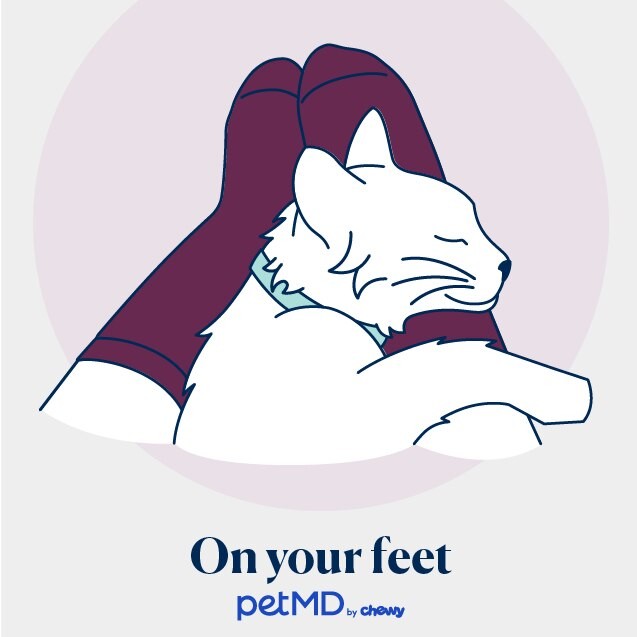Why Does My Cat Sleep Between My Legs? Discover the reasons behind this behavior and learn about feline sleeping habits with WHY.EDU.VN. Explore the potential warmth, security, and bonding aspects, and gain insight into your cat’s comfort and trust, leading to a deeper understanding of your furry friend’s affection and behavior.
Table of Contents
- Understanding Feline Sleeping Habits
- Reasons Why Your Cat Sleeps Between Your Legs
- 2.1 Seeking Warmth and Comfort
- 2.2 A Sense of Security
- 2.3 Bonding and Affection
- 2.4 Claiming Territory
- 2.5 Medical Reasons
- Decoding Other Cat Sleeping Positions
- 3.1 Curled Into a Ball
- 3.2 On Their Back
- 3.3 Side Sleeping
- 3.4 In a Loaf Shape
- 3.5 The Superman Pose
- 3.6 Perched on Furniture or Appliances
- 3.7 In Strange Positions
- 3.8 Sitting Upright
- 3.9 On Your Chest
- 3.10 Next to You
- 3.11 On Your Head
- 3.12 On Your Feet
- 3.13 In a Box
- 3.14 In the Litter Box
- 3.15 Eyes Open or Half Open
- 3.16 Paws Over Eyes
- 3.17 With Other Cats
- 3.18 With a Dog
- 3.19 Tucked In
- When to Worry About Your Cat’s Sleeping Habits
- Creating a Comfortable Sleeping Environment for Your Cat
- Expert Insights on Feline Behavior
- Addressing Common Concerns
- The Role of WHY.EDU.VN in Understanding Cat Behavior
- FAQ: Common Questions About Cat Sleeping Habits
- Conclusion: Embracing the Enigmatic World of Cat Sleep
1. Understanding Feline Sleeping Habits
Cats are known for their love of sleep. In fact, they can sleep up to 16 hours a day. According to PetMD, cats sleep so much due to their evolutionary history as predators. In the wild, cats expend a lot of energy hunting, so they need to conserve energy by sleeping. This instinct remains even in domesticated cats. Understanding these feline tendencies helps in interpreting their various sleeping positions and habits.
Cats are crepuscular animals, meaning they are most active during dawn and dusk. This affects their sleeping patterns, as they tend to be more awake and playful during these times and sleep more during the day and night. Their sleep patterns are also influenced by factors like age, health, and environment. Kittens and older cats generally sleep more, while cats with certain health conditions may also experience changes in their sleeping habits. A comfortable and safe environment is crucial for ensuring your cat gets adequate rest.
2. Reasons Why Your Cat Sleeps Between Your Legs
“Why does my cat sleep between my legs?” This is a common question among cat owners. There are several reasons why your cat might choose this particular sleeping spot. Understanding these reasons can help you better understand your cat’s needs and behaviors. Let’s delve into the most common explanations.
2.1 Seeking Warmth and Comfort
Cats have a higher body temperature than humans, typically between 100.5 and 102.5 degrees Fahrenheit. This means they are more sensitive to cold and often seek out warm places to sleep. Sleeping between your legs provides a cozy and warm environment for your cat. According to a study published in the Journal of Veterinary Behavior, cats often choose sleeping spots based on temperature and comfort.
Your body heat can be very appealing to your cat, especially during colder months. By snuggling between your legs, your cat can maintain their body temperature and feel comfortable. This behavior is more pronounced in breeds with shorter fur, as they are more susceptible to cold.
2.2 A Sense of Security
Cats are both predators and prey, so they constantly assess their environment for potential threats. Sleeping in a vulnerable position, such as between your legs, indicates that your cat feels safe and protected around you. This behavior is rooted in their survival instincts.
The enclosed space between your legs can feel like a secure den for your cat, offering a sense of protection from potential dangers. According to animal behaviorist Dr. Sarah Hodges, “Cats seek out enclosed spaces to reduce anxiety and feel more secure.” This sense of security is especially important for cats who may be more timid or anxious.
2.3 Bonding and Affection
Sleeping close to you is a sign of affection and bonding. Cats often sleep near people they trust and feel close to. By choosing to sleep between your legs, your cat is showing that they consider you part of their social group.
Cats express affection in various ways, and sleeping near you is one of them. This behavior can be traced back to their kittenhood, where they would sleep close to their mother and siblings for warmth and security. As your cat grows, they transfer this behavior to their human companions. A study in Applied Animal Behaviour Science found that cats who sleep with their owners have stronger bonds and exhibit fewer signs of separation anxiety.
2.4 Claiming Territory
Cats are territorial animals, and they use scent marking to establish their territory. By sleeping between your legs, your cat is leaving their scent on you, effectively marking you as part of their territory. This behavior is a natural way for cats to communicate their ownership and establish their presence.
Cats have scent glands on their paws, flanks, and head. When they rub against you or sleep on you, they transfer their scent, which contains pheromones that other cats can detect. While humans cannot smell these pheromones, they play a crucial role in feline communication. According to cat behavior expert Pam Johnson-Bennett, “Scent marking is a vital aspect of a cat’s social life and helps them feel secure in their environment.”
2.5 Medical Reasons
In some cases, a cat sleeping between your legs could be a sign of a medical issue. If your cat suddenly starts sleeping in this position and exhibits other symptoms, such as lethargy, loss of appetite, or changes in litter box habits, it’s essential to consult with a veterinarian.
While less common, certain medical conditions can cause cats to seek out warmth and security. For example, cats with arthritis or other joint problems may find the warmth between your legs soothing. Similarly, cats with anxiety or stress may seek out the comfort of your presence. If you notice any unusual behavior, it’s always best to err on the side of caution and seek professional veterinary advice.
3. Decoding Other Cat Sleeping Positions
Besides sleeping between your legs, cats exhibit a variety of other sleeping positions, each with its own meaning. Understanding these positions can provide valuable insights into your cat’s state of mind and overall well-being.
3.1 Curled Into a Ball
Cats often sleep curled up in a ball, with their nose to their tail. This position helps them conserve body heat and protect their vital organs. According to veterinarian Dr. Stuart Hovis, this position is a natural way for cats to stay warm and feel secure.
3.2 On Their Back
When a cat sleeps on their back with their belly exposed, it’s a sign that they feel very safe and comfortable. Cats instinctively protect their vulnerable organs, so this position indicates a high level of trust.
3.3 Side Sleeping
Similar to sleeping on their back, side sleeping with legs stretched out indicates that your cat is comfortable and relaxed. This position also allows them to quickly jump up and react if needed.
3.4 In a Loaf Shape
In this position, the cat keeps their front paws curled underneath their body with their head up, resembling a loaf of bread. This position allows them to preserve body heat and protect their vital organs while remaining alert.
3.5 The Superman Pose
Lying on their belly with front and back legs stretched out, like Superman in flight, allows the cat to relax while remaining ready for action. This pose also protects their vulnerable belly.
3.6 Perched on Furniture or Appliances
Sleeping on high vantage points, such as the back of a couch or the top of a refrigerator, allows the cat to feel safe from potential predators and keep an eye on their surroundings.
3.7 In Strange Positions
Cats are incredibly flexible, thanks to their elastic spinal column and loosely attached shoulder blades. This allows them to sleep in positions that may seem uncomfortable to humans.
3.8 Sitting Upright
Sleeping in a sitting position indicates that the cat feels safe enough to expose their belly. It also allows them easy access to groom themselves.
3.9 On Your Chest
Sleeping on your chest indicates a strong bond and a desire to be close to you. The cat may also be soothed by the sound of your heartbeat and the rhythmic motion of your breathing.
3.10 Next to You
Lying next to you, but not on you, indicates that the cat trusts you but prefers a small buffer zone. This position allows them to feel close while maintaining a sense of security.
3.11 On Your Head
Sleeping on your head provides a soft and warm place to nap. The cat may also want to be near you and have easy access to wake you up for food or attention.
3.12 On Your Feet
Sleeping on your feet allows the cat to stay close to you while maintaining an easy escape route. It also provides warmth for both the cat and your feet.
3.13 In a Box
Boxes provide a sense of security and warmth, similar to a den. Cats enjoy fitting into small spaces to feel protected and secure.
3.14 In the Litter Box
If a cat is sleeping or lying in their litter box, it could indicate a medical issue. Consult with a veterinarian immediately if you notice this behavior.
3.15 Eyes Open or Half Open
Cats can sleep with their eyes fully or partially open. This is often normal, but it’s important to rule out any medical reasons, such as eye problems.
3.16 Paws Over Eyes
Covering their eyes with their paws can provide insulation and warmth, as well as block out harsh light or irritants.
3.17 With Other Cats
Cats who are bonded to each other may sleep together for companionship, warmth, and comfort.
3.18 With a Dog
Cats can form bonds with dogs and sleep together for companionship, warmth, and comfort.
3.19 Tucked In
Sleeping under the covers provides warmth, security, and comfort. The cat may also enjoy the familiarity of your scent.
4. When to Worry About Your Cat’s Sleeping Habits
While most changes in a cat’s sleeping habits are normal, some may indicate a health issue. According to the American Animal Hospital Association (AAHA), sudden changes in sleeping patterns should be monitored. Here are some signs that warrant a visit to the veterinarian:
- Increased sleeping: If your cat is sleeping more than usual and seems lethargic, it could be a sign of illness.
- Decreased sleeping: If your cat is restless and unable to sleep, it could be due to anxiety or pain.
- Changes in sleeping location: If your cat suddenly starts sleeping in unusual places, such as the litter box, it could indicate a medical or behavioral problem.
- Other symptoms: If your cat exhibits other symptoms, such as loss of appetite, vomiting, diarrhea, or changes in litter box habits, it’s essential to seek veterinary care.
5. Creating a Comfortable Sleeping Environment for Your Cat
Providing a comfortable and safe sleeping environment is crucial for your cat’s well-being. Here are some tips to create the perfect sleeping space:
- Offer multiple sleeping options: Provide a variety of beds, blankets, and hiding places to cater to your cat’s preferences.
- Choose quiet and safe locations: Place your cat’s beds in quiet areas away from high-traffic zones and potential stressors.
- Maintain a consistent temperature: Ensure the sleeping area is warm in the winter and cool in the summer.
- Keep the area clean: Regularly clean your cat’s beds and blankets to prevent the buildup of dirt and allergens.
- Provide vertical space: Cats enjoy climbing and perching, so consider adding cat trees or shelves to their environment.
6. Expert Insights on Feline Behavior
Understanding feline behavior requires insights from experts in the field. Organizations like the International Cat Association (TICA) and the Cat Fanciers’ Association (CFA) provide valuable resources and information on cat behavior and care. Consulting with a veterinarian or a certified cat behaviorist can also provide personalized advice for your cat’s specific needs.
7. Addressing Common Concerns
Many cat owners have questions about their cat’s sleeping habits. Here are some common concerns and their solutions:
| Concern | Solution |
|---|---|
| My cat sleeps too much. | Ensure your cat is getting enough exercise and mental stimulation. If you’re concerned, consult with your veterinarian to rule out any medical issues. |
| My cat won’t sleep in their bed. | Try different types of beds and locations to find what your cat prefers. You can also try placing a blanket with your scent on the bed to make it more appealing. |
| My cat wakes me up at night. | Provide plenty of playtime and feeding before bedtime to tire your cat out. You can also try using an automatic feeder to provide a small meal during the night. |
| My cat sleeps in strange positions. | As long as your cat seems comfortable and healthy, sleeping in strange positions is usually nothing to worry about. Cats are flexible and can sleep in positions that may seem uncomfortable to humans. |
| My cat suddenly changed sleeping habits. | Monitor your cat for other symptoms and consult with your veterinarian if you’re concerned. Sudden changes in sleeping habits can sometimes indicate a medical issue that needs to be addressed. |










8. The Role of WHY.EDU.VN in Understanding Cat Behavior
At WHY.EDU.VN, we understand the importance of accurate and reliable information when it comes to understanding your pet’s behavior. We provide a platform where you can find expert-backed articles, answers to your specific questions, and connect with professionals in the field. Whether you’re wondering, “Why does my cat sleep between my legs?” or have other concerns about your cat’s behavior, WHY.EDU.VN is here to provide the answers you need.
We understand the challenges pet owners face in finding trustworthy information. The internet is flooded with advice, but not all of it is accurate or reliable. That’s why we’ve created a platform that connects you with experts and provides evidence-based information to help you make informed decisions about your pet’s care. If you’re struggling to understand your cat’s behavior or have specific questions that need answering, don’t hesitate to visit WHY.EDU.VN. Our team of experts is here to help you navigate the complexities of cat behavior and provide the support you need to ensure your furry friend is happy and healthy.
9. FAQ: Common Questions About Cat Sleeping Habits
Here are some frequently asked questions about cat sleeping habits:
- Is it normal for cats to sleep so much? Yes, cats typically sleep between 12 and 16 hours a day.
- Why does my cat sleep on me? Cats sleep on their owners for warmth, security, and affection.
- How can I make my cat’s sleeping area more comfortable? Provide soft beds, blankets, and quiet locations.
- Should I be worried if my cat’s sleeping habits change? Monitor your cat for other symptoms and consult with a veterinarian if you’re concerned.
- Why does my cat sleep with their eyes open? Cats can sleep with their eyes open or partially open to stay alert.
- Is it okay to let my cat sleep in my bed? It’s a personal choice, but many cat owners enjoy the companionship.
- Why does my cat sleep in a box? Boxes provide a sense of security and warmth for cats.
- How can I tell if my cat is getting enough sleep? Look for signs of relaxation, such as slow breathing and a relaxed posture.
- Why does my cat knead before sleeping? Kneading is a behavior rooted in kittenhood and is a sign of comfort and contentment.
- What should I do if my cat is sleeping in the litter box? Contact your veterinarian immediately, as this could indicate a medical issue.
10. Conclusion: Embracing the Enigmatic World of Cat Sleep
Understanding why your cat sleeps between your legs is just one piece of the puzzle when it comes to comprehending feline behavior. By observing their sleeping habits, body language, and overall demeanor, you can gain valuable insights into their needs and emotions. Remember, every cat is unique, and their behavior is influenced by a variety of factors, including their personality, environment, and health.
For more in-depth answers and expert advice, visit WHY.EDU.VN, where you can explore a wealth of information on cat behavior and connect with professionals who can help you better understand your furry friend. If you have any burning questions or concerns about your cat’s behavior, don’t hesitate to reach out to us. Our team of experts is here to provide the support and guidance you need to ensure your cat is happy, healthy, and well-adjusted.
Have more questions about your cat’s behavior? Need personalized advice from experienced professionals? Visit WHY.EDU.VN today and discover the answers you’ve been searching for. Our platform provides a wealth of information, expert insights, and the opportunity to connect with a community of passionate pet owners.
Contact us:
Address: 101 Curiosity Lane, Answer Town, CA 90210, United States
Whatsapp: +1 (213) 555-0101
Website: why.edu.vn